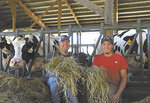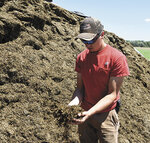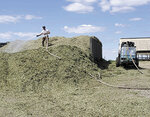The Greden family: Larry and Nancy; and Ross and Victoria, along with their children, Josie, Lydia, Megan and Ethan.
Greden Farms LLC
Altura, Minnesota
Winona County
550 cows
Describe your farm and facilities. We are a sixth-generation dairy farm, have been in business since 1866 and have a double-12 parallel parlor which was built in 1995. We also raise our own heifers on three sites. We also work together on a daily basis with three generations of family at all levels, and it is very challenging but also rewarding. The communication has to be magnified in order to achieve this successfully.
What forages do you harvest? We harvest alfalfa haylage, corn silage, winter rye (we call it ryelage), dry grass hay, alfalfa hay and oatlage. We plant oat as a companion or nurse crop in the spring with alfalfa, and then on the most erodible fields, we allow it to mature. In early July, we harvest the forage when the oats are headed out, and we chop that for heifer feed. If we have a fourth-year alfalfa field that is petering out, or the yield is not as good as the first couple years, we’ll take two cuttings of the alfalfa, and then we will apply or inject manure mid-to-late July into those acres. From Aug. 1 to 15, depending on the weather, we will direct seed oats only into the alfalfa which was just injected with manure, and then the oats gives us an October forage crop that we can chop in early October. Our winter rye is a cover crop, but we like the benefits of it as a forage because it gives us a lot of tonnage early in the year when our forage supplies start dwindling. It’s a nice tool in the toolbox. We also plant an August planting, or summer fallow, of alfalfa which is direct seeded following the harvest of peas. We have a contract with Lakeside in Plainview to plant peas which we plant June 1 and harvest the end of July. We have had very good success with those alfalfa plantings because the soil temperature is much higher and the weed pressure is much lower.
How many acres of crops do you raise? We have 70 acres of pasture ground for rotational grazing, 500 acres of corn and 300 acres of alfalfa, and on a selected portion of those same acres, we plant winter rye on our corn silage acres. This year, we planted 120 acres of winter rye which was harvested for forage. After the forage harvest in May, we planted corn, some of which we no tilled directly into the rye stubble, some of which we injected manure and then finished the field and planted corn, and then some of it we used a vertical tillage machine which used a light tillage to plant 30-inch corn. Our corn planter allows us the option of 15- or 30-inch spacings, and we’ve had better yield with our 15-inch when it comes to corn silage tonnage. So, we use the 30-inch for high moisture corn and 100% of our 30-inch corn goes to high moisture corn.
Describe the rations for your livestock. Two-thirds corn silage and one-third haylage for forages. We also add in high moisture corn, a protein product we purchase from the local co-op, dry corn, whole cottonseed and corn gluten pellets.
What quality and quantity do you harvest of each crop? Our goal for the relative feed value on our haylage is 200+, and we monitor the quality. We want a very high-quality forage. We use the HarvXtra alfalfa brand and low lectin varieties to get a higher quality product. We also use the aerial fungicide which is applied via helicopter in the spring on our better alfalfa fields. We get a little higher RFV because it promotes leaf retention in the lower portion of the stem. It’s been an expensive investment, but an investment that has paid off. We like to harvest 3,000 tons of haylage, 7,000 tons of corn silage and try to harvest our corn silage at 60% moisture.
Describe your harvesting techniques for alfalfa and corn silage. For the alfalfa, we try to have the cutting interval of 28 to 30 days and keep that quality very, very high. We are blessed with our own self-propelled chopper, self-propelled Discbine and a merger. Thankfully, all four children participate in the alfalfa harvest. My youngest daughter, Megan, runs the Discbine and cuts the hay. The older two daughters, Josie and Lydia, take turns on the merger and hauling loads. My son, Ethan, operates the chopper or the packing tractor on the pile. My dad, Larry, hauls loads or runs a packing tractor on the pile. I take turns on the chopper or the packing tractor on the pile. The windows of harvest opportunity are very small, we are forced to do four days of work in three days and go all night long to harvest the forage because the rain is coming. It’s been challenging to get the high-quality forages because you really have to get lucky on good weather. We have to do whatever it takes for that cow to make her as efficient and productive as we can make her, and sometimes we have to sacrifice a good night’s sleep to do that.
What techniques do you use to store, manage and feed your forages? Everything is in a flat storage, bunker or silo of some type. We have side walls on the majority of storage facilities, and we also have flat black top pads for our corn silage. We normally use a top dress inoculate product on our haylage piles as well as an oxygen barrier product. We fill the bunker, pack it very well, apply the inoculate product to the top of the pile, apply an oxygen barrier, put a black and white thicker plastic over the top and then tires as the last step. We’re very particular about maintaining a clean face on the bunker pile and try to remove at least 6 inches per day off each face. And, we use the Kostar Moisture Test at least on a weekly basis to monitor changes as we go through the pile.
Describe a challenge you overcame in reaching your forage quality goals. Historically, our chopper did not come with the ability to monitor and measure the moisture, so two years ago we added a harvest lab technology to our chopper and can now do a better job of getting a more consistent pile of forage because we know exactly what we are working with as we move across the field. And, if we get into a field that’s too wet, we just put a time out on it and move to a different field and come back when the moisture is right. We also had a challenge with the feed samples showing too high of an ash count and invested in a 32-foot Brillion roller and added it as a step to our alfalfa management. We soil finish the field, roll the field to firm it up, and then we direct seed with our alfalfa Brillion direct seeder. There are also times when we go back for a final rolling over the top to make it as firm as we can get it. The roller helps to eliminate the ridges, make it smooth and reduce the ash content in the forage and has really paid off.
How do quality forages play a part in the production goals for your herd? The higher the quality, the better the milk production. Larry also submitted the orchard grass alfalfa hay mixture which got eighth at the 2021 World Forage Superbowl. We grow the orchard grass alfalfa mixture on 60 acres and use it for our transition group. It has helped us reduce our displaced abomasum’s significantly and improve butterfat. It’s going on its eighth year and is very long lasting and high quality. We feed it to all of our transition cows from closeup to lactating.
What are management or harvesting techniques you have changed that have made a notable difference in forage quality? Variable rate technology application of lime which corresponds with the grid sampling of storage samples. The grid sampling of data calls for an aggressive amount of lime to raise the pH in one corner of the field. The balance of the field requires a lower application rate instead of going and managing per field. The VRT allows you to apply those little pockets that really need a lot more. It’s more efficient and cost effective. We’ve done that with fertility and pot ash especially. The harvest lab technology on the chopper also gives us more information to make better management decisions to achieve the higher quality feed. And, the roller lowers the ash count.



Comments
No comments on this item Please log in to comment by clicking here